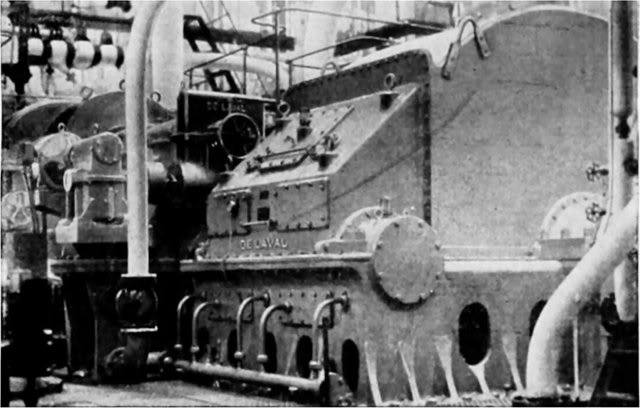Auke Visser's International Esso Tankers site | home
Geared Steam Turbines in American Ships
By Geo. H. Gibson
American ship owners are sometimes chided because of their steadfast adherence to steam power in preference to newer systems of propulsion. Questions of this nature, however, are ultimately decided by the economic outcome, into which enter not only such highly important matters as fuel consumed per shaft horsepower, but also considera-tions relating to space occupied, weight, first cost, cost of attendance, adaptability to various fuels, and, most impor-tant of all, reliable performance of power plant. Improvements to the steam cycle have been continuous and rapid
during the past ten years, and many ships equipped with modern steam plants have in extended service given am-ple assurance of reliable and economical operation, and have also demonstrated in practice the superior fuel sa-vings aimed at in recent developments, even though the improvement in efficiency has by no means as yet reached its culmination.
The progress which has been made in steam power equipments can be studied in the following illustrative cases.
with the reciprocating engined ships.
 Tanker G. Harrison Smith and the De Laval geared turbine in her engine room.
In 1930 the Standard Shipping Co., New York, put into service two 20,615 ton bulk oil tankers, the G. Harrison Smith and the W. S. Farish, each driven by De Laval compound double geared turbines developing a maximum of 4400 s.h.p. at 77.5 r.p.m. propeller speed and 4000 s.h.p. at 75 r.p.m., and using steam at 400 lb. gage and 750 degrees Fahrenheit total temperature. The electric driven auxiliaries normally receive current from a generator coupled to the
highly efficient main units, current being supplied at other times by auxiliary turbine driven generators. The boiler feed water is heated regeneratively by steam extracted from the main unit, while waste heat is recovered from the flue gases by an air heater. In three years' service, up to the end of 1933, the G. Harrison Smith had transported 65 cargoes, and the W. S. Farish 59 cargoes. The engine room logs for 1931-2-3 are summarized in the table here-with:
The pounds of fuel per 1000 ton miles of cargo carried was obtained by dividing the total pounds of fuel by the pro-duct of average cargo per loaded voyage and miles from sea buoy to sea buoy.
Comparison of the G. Harrison Smith with the reciprocator-powered John D. Archibald, of the same line and of ap-proximately the same size, shows that during the period from October 1930 to September 1931, when the Smith averaged 11.11 knots and the Archibald 10.5 knots, the Smith's fuel consumption averaged 165 bbl. daily and the Archibald 285 bbl. The turbine ship's average consumption of fuel per shaft horsepower per hour was approximately .61 lb. while that of the reciprocating tanker was more than twice as much.
Source : Pacific Marine Review, Volume 32, Januari, 1935.
|